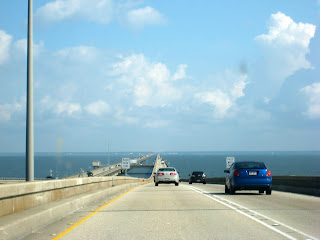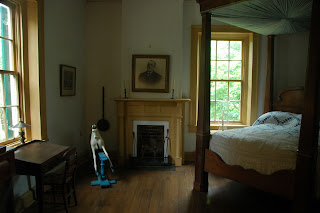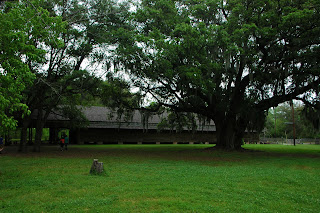The Lake Ponchartrain Causeway connects Metairie (one of the largest suburbs of New Orleans) to the south with Mandeville to the north. At 23.83 miles, it is the longest continuous bridge over water in the world. I figured that alone was worth the toll for the return trip ($3.00 southbound), since I like bridges. Being so long and flat, it seems to stretch on ad infinitum, 6 crossovers where police like to hang out and a few elevated areas being the only things to break up the monotony.
Because bridges are supposed to connect points of interest more than they are supposed to be points of interest themselves, I decided to look for something of interest to visit on the north end. Mandeville is a small suburb city of about 11,500 people, and a search of it turned up about as many points of interest as you would expect to find in a small suburb - not much. One thing that stood out is that it is home to the world's largest live oak tree, the Seven Sisters Oak, so I planned to check it out before turning around to drive back on the southbound span.
When I got off the bridge, I turned into a gas station to inquire where I could find the tree. The first girl I asked looked at me with a blank daze. "You're looking for... a tree?" I could tell I would get nothing from her. Fortunately, there was another woman there, and though she didn't know exactly which tree I was looking for, she gave me directions to a nearby street where some massive old growth oaks were.
Continuing my tour through bayou country, I drove to nearby Destrehan Plantation, an antebellum plantation built in the late 1780's, making it the oldest plantation house in the Mississippi Valley. As Bobby Ray says in the movie Sweet Home Alabama, "A plantation by any other name is just a farm. But it does roll off the tongue a little sweeter, doesn't it?", and the Destrehan Plantation is no exception. It's original cash crop was indigo, before sugar cane replaced it, but it now subsists on tourism, most of it's lands being sold off, leaving the house and a few support buildings.
 The grounds of the plantation are covered in majestic oaks - many approaching the size of the ones in Mandeville. The tour started off with us walking under one of these beautiful trees, around the back of the building. The back side is the only part of the structure that lacks the wide, open galleries that wrap around the front and sides. Instead, it hosts a pair of large cisterns that originally supplied the water for the plantation.
The grounds of the plantation are covered in majestic oaks - many approaching the size of the ones in Mandeville. The tour started off with us walking under one of these beautiful trees, around the back of the building. The back side is the only part of the structure that lacks the wide, open galleries that wrap around the front and sides. Instead, it hosts a pair of large cisterns that originally supplied the water for the plantation.After a brief history of the crops, the tour headed around the side, to a kitchen that was added to the house when two wings were build on either side (one of the outbuildings is a reproduction of a stand alone kitchen). We entered through a side door in the bottom floor of the house, into a food preparation room where servants originally staged cooked food from the separate kitchen, and prepared any food that didn't require cooking. From here, we moved through the great room that served as the foyer, lounge, and dining area, to an adjacent room that has been turned into a theatre, where a short movie gives more history on the house and it's owners.
 Heading upstairs, the tour continued into a room that was left unrestored to show the wood-slat structure of the upper floor's construction.
Heading upstairs, the tour continued into a room that was left unrestored to show the wood-slat structure of the upper floor's construction.
 From the second floor porch, we accessed the upper level of the wings, which contain a billiards/game room and additional bedrooms. We were also able to see some of the outside wall construction.
From the second floor porch, we accessed the upper level of the wings, which contain a billiards/game room and additional bedrooms. We were also able to see some of the outside wall construction.Though this concluded the guided tour, I followed the group to one of the outbuildings. The organization that runs and maintains the plantation features demonstrations of various period activities Monday through Saturday, including open hearth cooking, bousillage construction (bousillage is one of the original building techniques, using a mud pack over wood framing to build up a wall before plastering), indigo dyeing, candle making, carpentry, and on the day I visited, African American Herbal Remedies was the demonstration.
The gentleman giving the demonstration was a modern day pharmacist with around 40 years of experience both in practice and as an educator. On the table in front of him were vials of various herbs, honey, leeches, kerosene, ear wax, spider webs, urine, and even manure, and other less well known medicinal treatments, which could cure or relieve just about any ailment of the time, and still are excellent options, equalling or exceeding the effectiveness of the modern treatments. After his demonstration, showing a few of his favorite natural remedies, and entertaining questions from the group, I hung around and talked to him about some of his background, research he'd done, and his work at reestablishing some of them as go-to options in modern practice.
After leaving the pharmacist, I checked out the rest of the outbuildings, including the mule barn, a sugar kettle, the kitchen, smokehouse, well, etc., on my way to the front of the house, completing my tour of the Destrehan Plantation.
Kraemer - Scenic Rte #79 (Bayou Byways)
After leaving the plantation, it was time to start my second of the route from the "Most Scenic Drives in America" book.
The first destination I chose to go to on this route was a small segue to the town of Kraemer - a hub for alligator processing and swamp tours according to the book. The small segue seemed a bit longer than it should have been, and was kind of disappointing. I didn't see any alligator processing plant to check out, and though the marsh water ways looked inviting, I wanted to get further along the route, and didn't want to pay for a boat tour (not that I saw any that seemed open).
Cypremort Point State Park
I drove through Houma, the next point of interest on the route, which is also considered a great place for swamp tours, and because of the description of it as the "Venice of America," with waterways lining the streets, where you are reportedly likely to see boats driving along next to you. I didn't see any of the promised appeal. Perhaps it's because my home is in an area where it's common to find alligator infested swamp waters and boat canals, or because it's just big enough that it didn't feel very interesting.
By the time I got to Houma, it was late afternoon, and I knew I would likely not get to my next destination, New Iberia, before nightfall, so I looked up possible campgrounds along the way. Cypremort Point State Park seemed like a decent destination that I could reach before sunset, so I headed up the road to it. It is a small park situated on the end of a peninsula jutting into Vermilion Bay - a really beautiful place to take in a sunset. When I got there, I found out that the only type of "camping" they allow is in cabins, though the ranger station was unmanned, so I considered staying there anyway, but after inspecting the restrooms, decided to drive on to New Iberia, so I could at least get a jump on the next day.





















































No comments:
Post a Comment